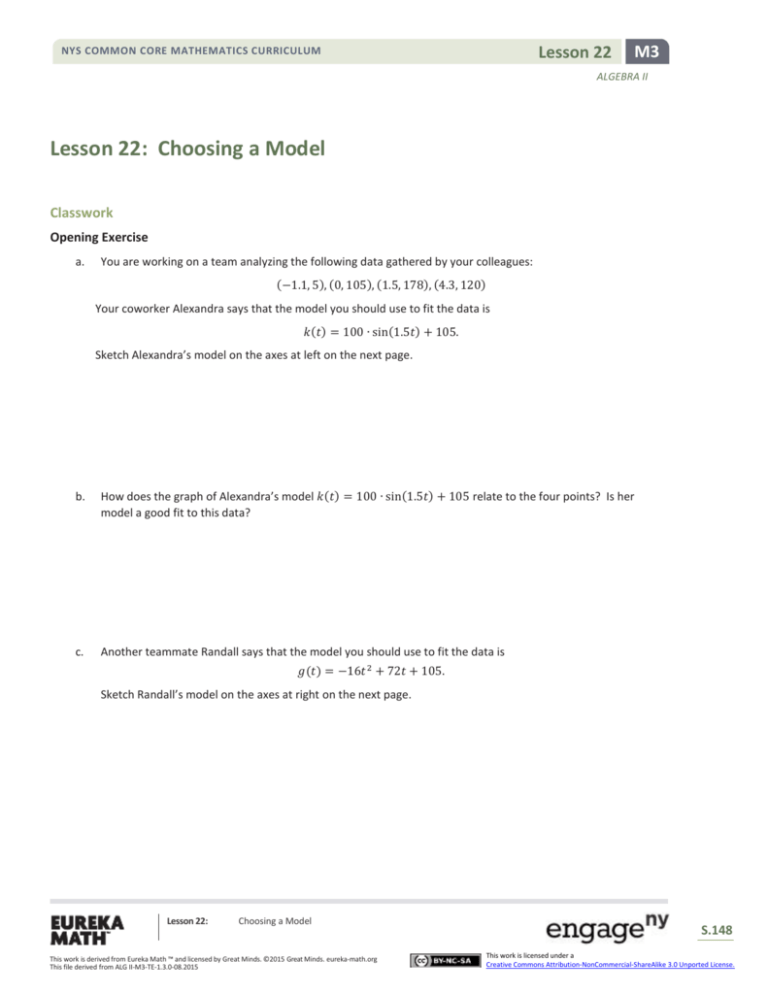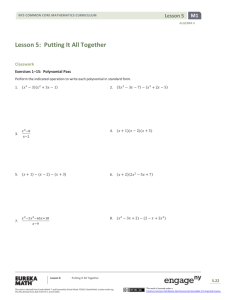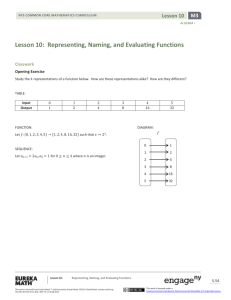Algebra II Module 3, Topic , Lesson 22: Student Version
advertisement

Lesson 22 NYS COMMON CORE MATHEMATICS CURRICULUM M3 ALGEBRA II Lesson 22: Choosing a Model Classwork Opening Exercise a. You are working on a team analyzing the following data gathered by your colleagues: (−1.1, 5), (0, 105), (1.5, 178), (4.3, 120) Your coworker Alexandra says that the model you should use to fit the data is 𝑘(𝑡) = 100 ∙ sin(1.5𝑡) + 105. Sketch Alexandra’s model on the axes at left on the next page. b. How does the graph of Alexandra’s model 𝑘(𝑡) = 100 ∙ sin(1.5𝑡) + 105 relate to the four points? Is her model a good fit to this data? c. Another teammate Randall says that the model you should use to fit the data is 𝑔(𝑡) = −16𝑡 2 + 72𝑡 + 105. Sketch Randall’s model on the axes at right on the next page. Lesson 22: Choosing a Model This work is derived from Eureka Math ™ and licensed by Great Minds. ©2015 Great Minds. eureka-math.org This file derived from ALG II-M3-TE-1.3.0-08.2015 S.148 This work is licensed under a Creative Commons Attribution-NonCommercial-ShareAlike 3.0 Unported License. Lesson 22 NYS COMMON CORE MATHEMATICS CURRICULUM M3 ALGEBRA II d. How does the graph of Randall’s model 𝑔(𝑡) = −16𝑡 2 + 72𝑡 + 105 relate to the four points? Is his model a good fit to the data? Alexandra’s Model Randall’s Model e. Suppose the four points represent positions of a projectile fired into the air. Which of the two models is more appropriate in that situation, and why? f. In general, how do we know which model to choose? Lesson 22: Choosing a Model This work is derived from Eureka Math ™ and licensed by Great Minds. ©2015 Great Minds. eureka-math.org This file derived from ALG II-M3-TE-1.3.0-08.2015 S.149 This work is licensed under a Creative Commons Attribution-NonCommercial-ShareAlike 3.0 Unported License. Lesson 22 NYS COMMON CORE MATHEMATICS CURRICULUM M3 ALGEBRA II Exercises 1. The table below contains the number of daylight hours in Oslo, Norway, on the specified dates. Date August 1 September 1 October 1 November 1 Hours and Minutes 16: 56 14: 15 11: 33 8: 50 Hours 16.93 14.25 11.55 8.83 a. Plot the data on the grid provided and decide how to best represent it. b. Looking at the data, what type of function appears to be the best fit? Lesson 22: Choosing a Model This work is derived from Eureka Math ™ and licensed by Great Minds. ©2015 Great Minds. eureka-math.org This file derived from ALG II-M3-TE-1.3.0-08.2015 S.150 This work is licensed under a Creative Commons Attribution-NonCommercial-ShareAlike 3.0 Unported License. NYS COMMON CORE MATHEMATICS CURRICULUM Lesson 22 M3 ALGEBRA II 2. c. Looking at the context in which the data was gathered, what type of function should be used to model the data? d. Do you have enough information to find a model that is appropriate for this data? Either find a model or explain what other information you would need to do so. The goal of the U.S. Centers for Disease Control and Prevention (CDC) is to protect public health and safety through the control and prevention of disease, injury, and disability. Suppose that 45 people have been diagnosed with a new strain of the flu virus and that scientists estimate that each person with the virus will infect 5 people every day with the flu. a. What type of function should the scientists at the CDC use to model the initial spread of this strain of flu to try to prevent an epidemic? Explain how you know. b. Do you have enough information to find a model that is appropriate for this situation? Either find a model or explain what other information you would need to do so. Lesson 22: Choosing a Model This work is derived from Eureka Math ™ and licensed by Great Minds. ©2015 Great Minds. eureka-math.org This file derived from ALG II-M3-TE-1.3.0-08.2015 S.151 This work is licensed under a Creative Commons Attribution-NonCommercial-ShareAlike 3.0 Unported License. NYS COMMON CORE MATHEMATICS CURRICULUM Lesson 22 M3 ALGEBRA II 3. 4. An artist is designing posters for a new advertising campaign. The first poster takes 10 hours to design, but each subsequent poster takes roughly 15 minutes less time than the previous one as he gets more practice. a. What type of function models the amount of time needed to create 𝑛 posters, for 𝑛 ≤ 20? Explain how you know. b. Do you have enough information to find a model that is appropriate for this situation? Either find a model or explain what other information you would need to do so. A homeowner notices that her heating bill is the lowest in the month of August and increases until it reaches its highest amount in the month of February. After February, the amount of the heating bill slowly drops back to the level it was in August, when it begins to increase again. The amount of the bill in February is roughly four times the amount of the bill in August. a. What type of function models the amount of the heating bill in a particular month? Explain how you know. b. Do you have enough information to find a model that is appropriate for this situation? Either find a model or explain what other information you would need to do so. Lesson 22: Choosing a Model This work is derived from Eureka Math ™ and licensed by Great Minds. ©2015 Great Minds. eureka-math.org This file derived from ALG II-M3-TE-1.3.0-08.2015 S.152 This work is licensed under a Creative Commons Attribution-NonCommercial-ShareAlike 3.0 Unported License. NYS COMMON CORE MATHEMATICS CURRICULUM Lesson 22 M3 ALGEBRA II 5. 6. An online merchant sells used books for $5.00 each, and the sales tax rate is 6% of the cost of the books. Shipping charges are a flat rate of $4.00 plus an additional $1.00 per book. a. What type of function models the total cost, including the shipping costs, of a purchase of 𝑥 books? Explain how you know. b. Do you have enough information to find a model that is appropriate for this situation? Either find a model or explain what other information you would need to do so. A stunt woman falls from a tall building in an action-packed movie scene. Her speed increases by 32 ft/s for every second that she is falling. a. What type of function models her distance from the ground at time 𝑡 seconds? Explain how you know. b. Do you have enough information to find a model that is appropriate for this situation? Either find a model or explain what other information you would need to do so. Lesson 22: Choosing a Model This work is derived from Eureka Math ™ and licensed by Great Minds. ©2015 Great Minds. eureka-math.org This file derived from ALG II-M3-TE-1.3.0-08.2015 S.153 This work is licensed under a Creative Commons Attribution-NonCommercial-ShareAlike 3.0 Unported License. Lesson 22 NYS COMMON CORE MATHEMATICS CURRICULUM M3 ALGEBRA II Lesson Summary If we expect from the context that each new term in the sequence of data is a constant added to the previous term, then we try a linear model. If we expect from the context that the second differences of the sequence are constant (meaning that the rate of change between terms either grows or shrinks linearly), then we try a quadratic model. If we expect from the context that each new term in the sequence of data is a constant multiple of the previous term, then we try an exponential model. If we expect from the context that the sequence of terms is periodic, then we try a sinusoidal model. Model Equation of Function Rate of Change Linear 𝑓(𝑡) = 𝑎𝑡 + 𝑏 for 𝑎 ≠ 0 Constant 2 𝑔(𝑡) = 𝑎𝑡 + 𝑏𝑡 + 𝑐 for 𝑎 ≠ 0 Quadratic 𝑐𝑡 Changing linearly Exponential ℎ(𝑡) = 𝑎𝑏 for 0 < 𝑏 < 1 or 𝑏 > 1 A multiple of the current value Sinusoidal 𝑘(𝑡) = 𝐴 sin(𝑤(𝑡 − ℎ)) + 𝑘 for 𝐴, 𝑤 ≠ 0 Periodic Problem Set 1. A new car depreciates at a rate of about 20% per year, meaning that its resale value decreases by roughly 20% each year. After hearing this, Brett said that if you buy a new car this year, then after 5 years the car has a resale value of $0.00. Is his reasoning correct? Explain how you know. 2. Alexei just moved to Seattle, and he keeps track of the average rainfall for a few months to see if the city deserves its reputation as the rainiest city in the United States. Month July September October December Average rainfall 0.93 in. 1.61 in. 3.24 in. 6.06 in. What type of function should Alexei use to model the average rainfall in month 𝑡? 3. Sunny, who wears her hair long and straight, cuts her hair once per year on January 1, always to the same length. Her hair grows at a constant rate of 2 cm per month. Is it appropriate to model the length of her hair with a sinusoidal function? Explain how you know. Lesson 22: Choosing a Model This work is derived from Eureka Math ™ and licensed by Great Minds. ©2015 Great Minds. eureka-math.org This file derived from ALG II-M3-TE-1.3.0-08.2015 S.154 This work is licensed under a Creative Commons Attribution-NonCommercial-ShareAlike 3.0 Unported License. Lesson 22 NYS COMMON CORE MATHEMATICS CURRICULUM M3 ALGEBRA II 4. 5. 6. On average, it takes 2 minutes for a customer to order and pay for a cup of coffee. a. What type of function models the amount of time you wait in line as a function of how many people are in front of you? Explain how you know. b. Find a model that is appropriate for this situation. An online ticket-selling service charges $50.00 for each ticket to an upcoming concert. In addition, the buyer must pay 8% sales tax and a convenience fee of $6.00 for the purchase. a. What type of function models the total cost of the purchase of 𝑛 tickets in a single transaction? b. Find a model that is appropriate for this situation. In a video game, the player must earn enough points to pass one level and progress to the next as shown in the table below. To pass this level… You need this many total points… 1 2 3 4 5,000 15,000 35,000 65,000 That is, the increase in the required number of points increases by 10,000 points at each level. 7. a. What type of function models the total number of points you need to pass to level 𝑛? Explain how you know. b. Find a model that is appropriate for this situation. The southern white rhinoceros reproduces roughly once every three years, giving birth to one calf each time. Suppose that a nature preserve houses 100 white rhinoceroses, 50 of which are female. Assume that half of the calves born are female and that females can reproduce as soon as they are 1 year old. a. What type of function should be used to model the population of female white rhinoceroses in the preserve? b. Assuming that there is no death in the rhinoceros population, find a function to model the population of female white rhinoceroses in the preserve. c. Realistically, not all of the rhinoceroses survive each year, so we assume a 5% death rate of all rhinoceroses. Now what type of function should be used to model the population of female white rhinoceroses in the preserve? d. Find a function to model the population of female white rhinoceroses in the preserve, taking into account the births of new calves and the 5% death rate. Lesson 22: Choosing a Model This work is derived from Eureka Math ™ and licensed by Great Minds. ©2015 Great Minds. eureka-math.org This file derived from ALG II-M3-TE-1.3.0-08.2015 S.155 This work is licensed under a Creative Commons Attribution-NonCommercial-ShareAlike 3.0 Unported License.









